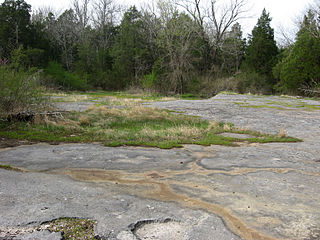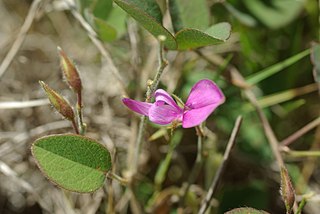
The Donald E. Davis Arboretum, in Auburn, Alabama, United States, is a public native plants museum, and botanical arboretum with educational facilities, event spaces, and a conservation program. Its grounds, covering 13.5 acres of Auburn University's campus, include cataloged living collections of associated tree and plant communities representative of Alabama's ecosystems, among which is mixed oak forest, carnivorous bog, and longleaf pine savanna. The living collections include more than 1,000 plant types, including 500 different plant species, with over 3,000 cataloged specimens. The Arboretum contains over a mile (2 km) of interwoven walking trails that meander through various southeastern biotopes.

Xerophyllum asphodeloides is a North American species of flowering plants in the Melanthiaceae known by the common names turkey beard, eastern turkeybeard, beartongue, grass-leaved helonias, and mountain asphodel. It is native to the eastern United States, where it occurs in the southern Appalachian Mountains from Virginia to Alabama, and also in the Pine Barrens of New Jersey.

A calcareous glade is a type of ecological community that is found in the central Eastern United States. Calcareous glades occur where bedrock such as limestone occurs near or at the surface, and have very shallow and little soil development. Due to the shallow soil and the extreme conditions created by it, trees are often unable to grow in the glades. This creates a habitat that is usually sunny, dry, and hot. Calcareous glade vegetation is more similar to that of a desert habitat than a grassland, being dominated by small spring annuals with occasional geophytic or succulent perennials.

Florida scrub is a forest ecoregion found throughout Florida in the United States. It is found on coastal and inland sand ridges and is characterized by an evergreen xeromorphic plant community dominated by shrubs and dwarf oaks. Because the low-nutrient sandy soils do not retain moisture, the ecosystem is effectively an arid one. Wildfires infrequently occur in the Florida scrub. Most of the annual rainfall falls in summer.

Croton alabamensis, known as Alabama croton, is a rare species of flowering plant in the spurge family, Euphorbiaceae, that is endemic to Texas and Alabama in the Southeastern United States. It has two varieties whose ranges are separated by more than 1000 km: Croton alabamensis var. alabamensis is found in two central Alabama counties, while Croton alabamensis var. texensis is found in three counties in Texas.

Cirsium vinaceum is a rare species of thistle known by the common name Sacramento Mountains thistle. It is endemic to Otero County, New Mexico, in the United States, where it is known only from the Sacramento Mountains. The plant can be found in six canyon systems in a southern section of this mountain range spanning about 32 kilometers. It is rare because it is limited to a specific type of mountain wetland which is both naturally uncommon and threatened by a number of forces. The plant was federally listed as threatened in 1987.

Conradina glabra is a rare species of shrub known by the common names Apalachicola rosemary or Apalachicola false rosemary. It is endemic to Liberty County, Florida, where it is known from about ten populations. It is found only in a small area and it is threatened by habitat destruction. It is a federally listed endangered species.

Asimina pulchella is a rare species of flowering plant in the custard apple family known by the common names beautiful pawpaw, royal false pawpaw, and white squirrel banana. It is a federally listed endangered species.

Asimina rugelii is a rare species of flowering plant in the custard apple family known by the common names Rugel's pawpaw, Rugel's false pawpaw, and yellow squirrel banana. It is endemic to Volusia County, Florida, in the United States, where there are fewer than 5000 plants remaining in severely fragmented habitat. The main threat to this species is habitat destruction and degradation. It was federally listed as an endangered species in 1986.
Dicerandra cornutissima is a rare species of flowering plant in the mint family known by the common names longspurred mint, longspurred balm, and Robin's mint. It is endemic to Florida in the United States. It is found in Marion County, and possibly Sumter County, but it may have been totally extirpated from the latter. There are 12 known occurrences remaining as of 2017, down from 15 in 2000. The plant was federally listed as an endangered species in 1985.

Dicerandra frutescens is a rare species of flowering plant in the mint family known by the common names scrub mint and scrub balm. It is endemic to Highlands County, Florida, where it is known only from the Lake Wales Ridge. Its habitat is quickly being lost as it is converted to residential and agricultural use. It was federally listed as an endangered species of the United States in 1985.

Euphorbia telephioides is a rare species of euphorb known by the common name Telephus spurge. It is endemic to Florida in the United States, where it is known only from three counties in the Panhandle. It is a federally listed threatened species of the United States.

Galactia smallii is a rare species of flowering plant in the legume family known by the common name Small's milkpea. It is endemic to Florida, where it is known only from a few small patches of remaining habitat in Miami-Dade County. It is threatened by the destruction and inadequate management of its habitat. It was federally listed as an endangered species of the United States in 1985.

Ipomopsis sancti-spiritus is a rare species of flowering plant in the phlox family known by the common name Holy Ghost ipomopsis. It is endemic to New Mexico in the United States, where it is known from only one canyon in the Sangre de Cristo Mountains. It is a federally listed endangered species.
Justicia cooleyi is a rare species of flowering plant in the family Acanthaceae known by the common name Cooley's water-willow. It is endemic to Florida in the United States, where it occurs in three counties. It is a federally listed endangered species.

Lupinus aridorum is a rare species of lupine known by the common name scrub lupine. It is endemic to Florida in the United States, where there were 10 known populations remaining in 2003. Fewer than 6000 individual plants were counted. It is threatened by the loss and degradation of its habitat. The scrub lupine is a federally listed endangered species of the United States.
Matelea alabamensis is a species of flowering plant in the dogbane family known by the common names Alabama milkvine, Alabama anglepod, and Alabama spiny-pod. It is native to the southeastern United States, where it occurs in Alabama, Georgia, and Florida.

Symphyotrichum georgianum is a rare species of flowering plant in the Asteraceae, the aster family. Its common name is Georgia aster. It is native to the southeastern United States where it is known from Alabama, Florida, Georgia, North Carolina, and South Carolina. As of 2013, it may be extirpated from the state of Florida.

Prunus alabamensis, the Alabama cherry or Alabama black cherry, is an uncommon to rare species of tree in the rose family endemic to parts of the Southeastern United States. It is closely related to and found wholly within the range of Prunus serotina, the black cherry, a more common and widespread species of Prunus also native to the region. Alabama cherry is sometimes considered to be a variety of Prunus serotina, however most authors treat it as a distinct species.

Croton alabamensis var. texensis is a variety of Croton alabamensis that is endemic to the state of Texas in the United States. It is commonly known as the Texabama croton.



















